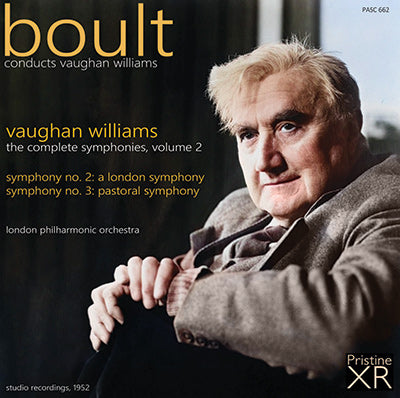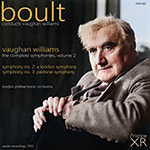
This album is included in the following sets:
This set contains the following albums:
- Producer's Note
- Full Track Listing
- Cover Art
The genesis of Vaughan Williams’s “London” Symphony, as recounted twice by the composer (in his essays “A Musical Autobiography” and “George Butterworth”) is well known. One day in 1910, Butterworth “said in his gruff, abrupt, manner: ‘You know, you ought to write a symphony.’ I answered, if I remember aright, that I had never written a symphony and never intended to.” As RVW admitted, “This was not strictly true”—twice before he had drafted movements of projected symphonies, “all now happily lost. I suppose that Butterworth’s words stung me” and in 1912–13 he worked up sketches originally intended for a symphonic poem into the symphony. It seems, then, as if he initially considered A Sea Symphony to be an extended secular cantata, and the “London” Symphony his first proper symphony. He showed his work to Butterworth as it progressed, “and it was then that I realized that he possessed, in common with very few composers, a wonderful power of criticism of other men’s work and insight into their ideas and motives. I can never feel too grateful to him for all he did for me over this work.” After Butterworth died in combat in World War I, RVW dedicated the score to him. In his old age he declared it to be his favorite among his own symphonies.
Geoffrey Toye conducted the premiere with the Queen’s Hall Orchestra at its home venue on Friday, March 27, 1914. Critical reaction was overwhelmingly laudatory; the critic for the Dorking and Leatherhead Advertiser declared that it was “not only the most masterly, but also the most beautiful work, musically or psychologically considered, from the pen of any musician of his generation that we have heard in recent years”; that for J. P.’s Weekly opined that it was “a symphony that is full of noble and unforgettable music.” There were a few dissenting voices; reviews in the Globe and Truth were tepid, while H. A. Scott for The Westminster Gazette dismissed it outright as “for the most part very dry and labored … dull in the extreme.” Most writers rightly grasped that the symphony was intended to be psychologically evocative of states of mind in beholding aspects of London, rather than graphically pictorial in the manner of a symphonic poem; in RVW’s own words it was a “work written solely in music and meant to appeal solely to the musical imagination of the hearers.” The Lento was singled out for its particular beauty. Several critics agreed that the finale was the weakest link and would be improved by being shortened. In the two bouts of revisions that RVW undertook in 1918–20 and 1933 he pruned that movement considerably, resulting in the version generally familiar today, though both the original 1913 and intermediate 1920 scores have also enjoyed recordings.
The “Pastoral” Symphony was composed in the aftermath of the war in 1919–20. This work often is alleged to have prompted Peter Warlock’s famous gibe that RVW’s music “is all just a little too much like a cow looking over a gate” (in fact Warlock had high praise for this symphony). This gave rise to the derisive nickname of “Cow Pat” school (coined by Elizabeth Lutyens in 1950) for the so-called “English Pastoralist” composers such as RVW, Butterworth, Finzi, Ireland, and Moeran. But the composer himself wrote in 1938 to Ursula Wood that the score “is really war time music … it’s not really Lambkins frisking at all as most people take for granted,” an embodiment of his reminiscences of fields in France where he served in the war as a medical orderly, and an elegy to those who fell there in combat. The famous trumpet tune in the second movement provided an initial idea for the work when a regimental bugler accidentally played an interval of a seventh instead of an octave.
The premiere was given by Adrian Boult on January 16, 1922, with the London Philharmonic and soprano soloist Flora Mann. Most critics seem to have been a bit nonplussed by the score’s sustained, subdued mood throughout its four movements; Ernest Newman penned a sour diatribe against it for The Sunday Times. Only recently have its many virtues gained proper appreciation; the present recording was its premiere on discs.
JAMES ALTENA
BOULT Vaughan Williams Symphonies, Volume 2
VAUGHAN WILLIAMS A London Symphony (Symphony No. 2)
1. 1st mvt. - Lento - Allegro resoluto (13:20)
2. 2nd mvt. - Lento (11:04)
3. 3rd mvt. - Scherzo (Nocturne) (7:03)
4. 4th mvt. - Finale. Andante con moto - Maestoso alla marcia - Lento - Epilogue (12:33)
VAUGHAN WILLIAMS Pastoral Symphony (Symphony No. 3)
5. 1st mvt. - Molto moderato (9:43)
6. 2nd mvt. - Lento moderato (8:19)
7. 3rd mvt. - Moderato pesante (6:22)
8. 4th mvt. - Lento (10:53)
Margaret Ritchie, soprano
London Philharmonic Orchestra
conducted by Sir Adrian Boult
XR Remastered by Andrew Rose
Cover artwork based on a photograph of Vaughan Williams
A London Symphony
Recorded 8 & 10 January 1952
Kingsway Hall, London
Pastoral Symphony
Recorded 12-13 December 1952
Kingsway Hall, London
Total duration: 79:17

